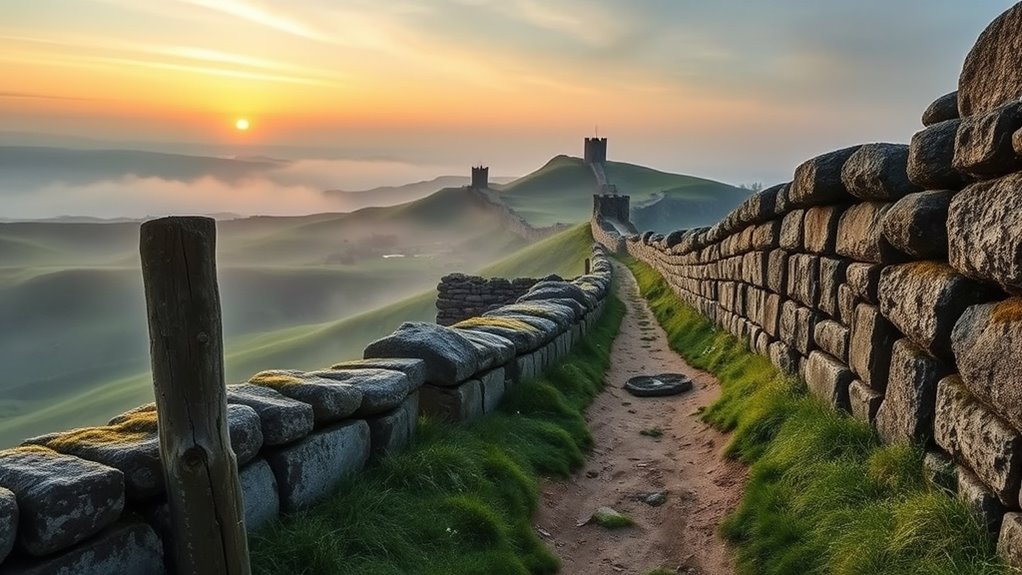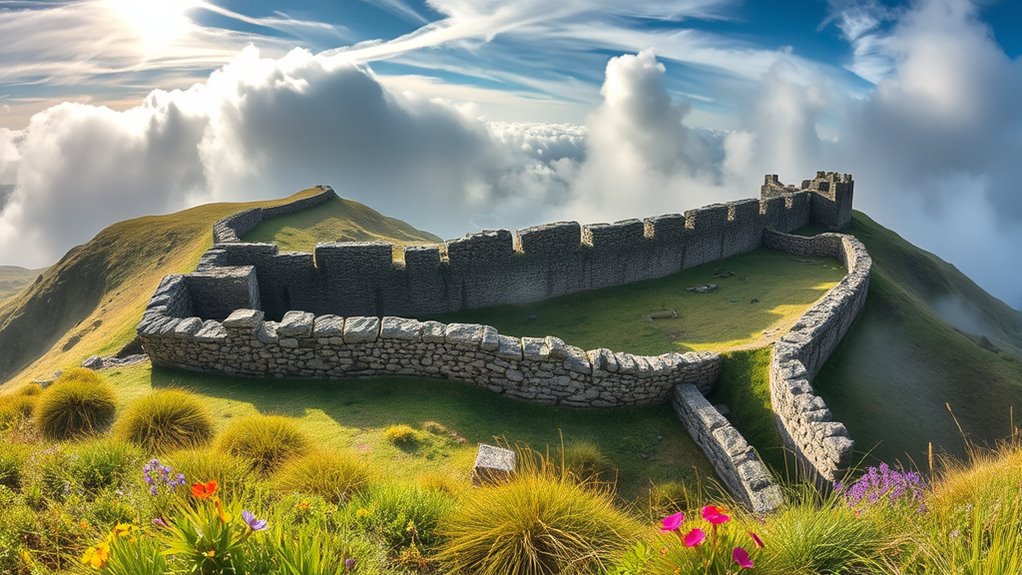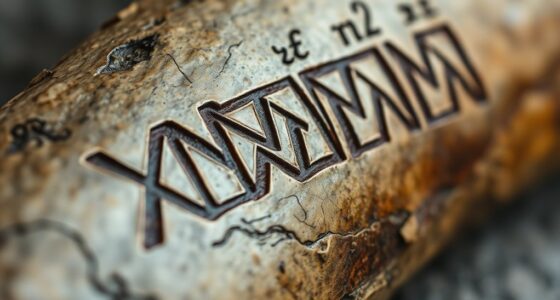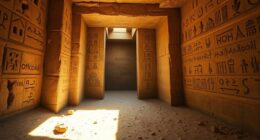Recent discoveries at Hadrian’s Wall give you a closer look at life on Rome’s northern frontier. You can see how the wall was not just a formidable military barrier but also a hub of strategic planning and daily activity for soldiers. The excavations reveal how Roman engineers built durable structures using local materials and designed forts and outposts with purpose. Keep exploring to uncover more about how this incredible feat of architecture shaped Roman control of Britain.
Key Takeaways
- Recent excavations uncover detailed insights into daily life of Roman soldiers stationed at Hadrian’s Wall.
- Discoveries include living quarters, artifacts, and tools revealing soldiers’ routines and social interactions.
- New digs highlight the strategic importance of forts and outposts along the frontier.
- Findings demonstrate how infrastructure supported military discipline and resilience on the Roman edge.
- Archaeological reveals deepen understanding of Roman engineering, culture, and frontier life during the 2nd century AD.

Hadrian’s Wall, built by the Romans in the 2nd century AD, served as a formidable frontier across northern Britain. As you explore this ancient structure, you’re stepping into a site that was once a essential part of the Roman military strategy. The Romans constructed Hadrian’s Wall not just as a barrier but as a symbol of their dominance and a line of defense against northern tribes. The wall’s design reflects their mastery of ancient architecture, combining functionality with impressive engineering. You can see how the Romans used locally sourced stone and turf to build a sturdy, enduring structure that still captures your imagination today.
Explore Hadrian’s Wall: a symbol of Roman strength, built with mastery and enduring local materials.
When you walk along the remnants of the wall, you’re walking through a landscape that was once teeming with activity. The Roman military played a crucial role here, stationed in forts and milecastles along the wall. These outposts weren’t just defensive positions; they functioned as command centers, supply depots, and places where soldiers could rest and regroup. The presence of these military installations highlights how the Romans managed to maintain control over this remote frontier, deploying disciplined troops to monitor and defend the border. You get a sense of their strategic thinking, as every stone and tower was placed with purpose, illustrating their advanced military logistics. The construction techniques used here demonstrate their mastery of ancient engineering.
Ancient architecture is on full display at Hadrian’s Wall, offering insights into Roman engineering prowess. The construction techniques used here influenced subsequent military architecture and demonstrate the Romans’ ability to adapt their skills to diverse environments. You can observe the precise stonework, the construction of forts with thick walls, and the design of defensive features like battlements and gateways. These elements weren’t just for defense—they also served as symbols of Roman strength and order. The remains of the wall reveal a complex network of corridors and chambers that housed soldiers, providing shelter and operational space. Every aspect of the architecture was designed for durability and efficiency, ensuring the wall’s role as a border barrier lasted centuries.
Standing here, you realize that Hadrian’s Wall isn’t just a relic; it’s a proof to Roman innovation and military discipline. Its ancient architecture and strategic placement tell stories of conquest, control, and resilience. As you explore further, you’ll see how this engineering marvel was more than just a wall—it was a statement of Roman power on the edge of their empire. This fascinating combination of military might and architectural ingenuity makes Hadrian’s Wall a compelling window into the past, inviting you to imagine life on the Roman frontier.
Frequently Asked Questions
What Animals Lived Near Hadrian’S Wall?
You’ll find that the native wildlife near Hadrian’s Wall included red deer, foxes, and badgers, thriving in the rugged landscape. Domesticated animals like sheep and cattle also grazed nearby, supporting local communities. These animals adapted well to the environment, with the native wildlife providing a glimpse into the natural history of the area, while domesticated animals helped sustain the people living on the frontier.
How Did Roman Soldiers Entertain Themselves?
Imagine yourself in Roman times, where entertainment was more than just leisure—it was a display of strength and ingenuity. Roman soldiers kept boredom at bay through games, storytelling, and physical competitions, all influenced by Roman military tactics and architectural innovations. These activities not only boosted morale but also reinforced discipline, blending leisure with lessons in warfare and engineering. Their entertainment reflected a society that valued both leisure and mastery of the skills that protected their empire.
Were There Any Secret Passages or Hidden Tunnels?
You wonder if there were secret tunnels or hidden passages at Hadrian’s Wall. Historians believe that some secret tunnels and hidden passages might have existed for strategic purposes, like smuggling or quick escapes. However, concrete evidence remains scarce, and many of these passages could be myths or lost over time. Still, the idea intrigues you, as secret tunnels would have offered significant advantages during military operations.
What Crops Were Cultivated by the Inhabitants?
You discover that the inhabitants practiced ancient farming and focused on crop cultivation suited to the northern climate. They grew barley, wheat, and oats, which provided staple foods and ingredients for brewing. Their farming methods involved clearing land, planting seeds carefully, and using simple tools. This crop cultivation supported their community, ensuring sustenance and trade, and offering a glimpse into how they adapted their agricultural practices to survive and thrive on the frontier.
How Did Weather Affect Life at Hadrian’S Wall?
You’d notice that climate impact and seasonal hardships greatly affected life at Hadrian’s Wall. Harsh winters and unpredictable weather challenged your daily routines, making farming and traveling difficult. Heavy rains could lead to flooding, while cold temperatures slowed crop growth. These conditions forced you to adapt your activities, store supplies carefully, and prepare for tough seasons, highlighting how weather played a vital role in shaping your life along the Roman frontier.
Conclusion
As you explore these new digs along Hadrian’s Wall, you realize how it once served as a formidable frontier, stretching nearly 80 miles across northern Britain. Did you know that at its peak, over 15,000 soldiers guarded this border? This discovery reveals not just the military might of Rome, but also the daily lives and resilience of those who lived on the edge of an empire. It’s a reminder that history’s legacy still stands strong today.









